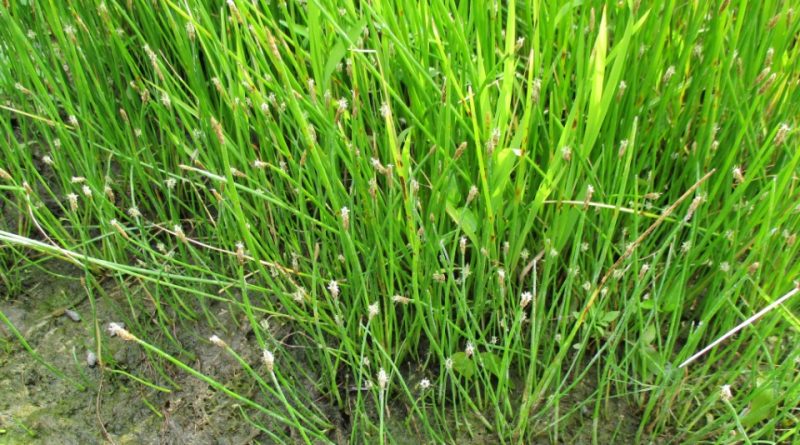Eleocharis palustris
Eleocharis palustris
Common Spike-Rush (Eleocharis palustris (L.) Roem. & Schult.) is a herbaceous species belonging to the Cyperaceae family.
Systematics –
From a systematic point of view it belongs to:
Eukaryota Domain,
Kingdom Plantae,
Magnoliophyta Division,
Liliopsida class,
Cyperales Order,
Cyperaceae family.
The following terms are synonymous:
– Eleocharis nebrodensis Parl .;
– Scirpus palustris L ..
Etymology –
The term Eleocharis comes from the Greek ἕλος hélos marsh and from χᾰρις cháris grace, beauty, ornament: a plant that embellishes the marshes.
The specific epithet palustris comes from pálus, palúdis swamp: marsh, for the habitat of growth.
Geographic Distribution and Habitat –
Eleocharis palustris is a plant found in almost all areas of the world, but with important gaps: a continent, a climatic zone.
Its habitat is that of marshy and marshy areas, lakes, rivers and streams, up to 600 m. s.l.m ..
Description –
Eleocharis palustris is a plant with a particular underground stem, called rhizome, which every year emits cylindrical, undivided, spongy and compressible adventitious roots and stems, with more than 20 vascular bundles, which grow between 20 and 60 cm.
The stems are of a bright green color.
The radical leaves are reduced to the sheath enveloping the stem for a few cm at the base, truncated, the upper with a dark line at the margin.
The flowers are inconspicuous hermaphrodites; the perianth is absent, replaced by acute glumes, surrounded by 3-4 short perigonial silks, articulated style on the ovary with bulbous enlargement.
The inflorescences are brown spikes, which then turn white with flowering. Each inflorescence is a single oval-lanceolate apical spike (10-20 mm), straw-yellow (then brown), with 6 perigonial silks shorter than the spike (2-3 mm); short bract.
Flowering is from May to September.
The fruit is a biconvex achene (cypsela) of 1.2-2 x 1-1.5 mm with an obovate to pyriform outline, biconvex, smooth or almost, yellowish, golden or dark green, opaque, with 20 or more vascular bundles ; stylopodium about 1/2 the width of the achenium and about the same length, obovate, spongy, deltoid or mammiform; 3-4 perigonial silks equal to or greater than achenium, brownish, golden or whitish.
Cultivation –
Eleocharis palustris is a plant that prefers slightly acid soils, growing well in shallow water or muddy soils.
Propagation can take place by seed with surface sowing in spring in pots immersed in shallow water. When they are large enough to handle, the individual plants can be transplanted into their own pots.
The planting for ponds or marshy areas or streams must be done with a depth between the rhizome and the water surface of 0 to -20 cm.
We recommend exposure in full direct sun for at least 6 hours a day.
It is a plant that withstands very harsh temperatures.
Customs and Traditions –
Eleocharis palustris, like all ciperaceae, is an aquatic plant that grows on humid substrates, therefore they are easily found in ponds and marshy soils. It can become a weed of abundantly irrigated lawns where it is easily distinguished by its lighter color, more compact habit and leathery leaves.
This plant was once also made edible by eating its sap.
Among other uses, this plant has been used as a bedding, cushion stuffing and to make cushions to sit on.
Preparation Method –
The Common Spike-Rush has no particular uses today for food or medicinal use while it has a certain importance as a plant for bio-pools and phyto-purification plants.
Guido Bissanti
Sources
– Acta Plantarum – Flora of the Italian Regions.
– Wikipedia, the free encyclopedia.
– Useful Tropical Plants Database.
– Conti F., Abbate G., Alessandrini A., Blasi C. (ed.), 2005. An annotated checklist of the Italian vascular flora, Palombi Editore.
– Pignatti S., 1982. Flora of Italy, Edagricole, Bologna.
– Treben M., 2000. Health from the Lord’s Pharmacy, Advice and experiences with medicinal herbs, Ennsthaler Editore.
Warning: Pharmaceutical applications and alimurgical uses are indicated for informational purposes only, they do not represent in any way a medical prescription; therefore no responsibility is taken for their use for curative, aesthetic or food purposes.


